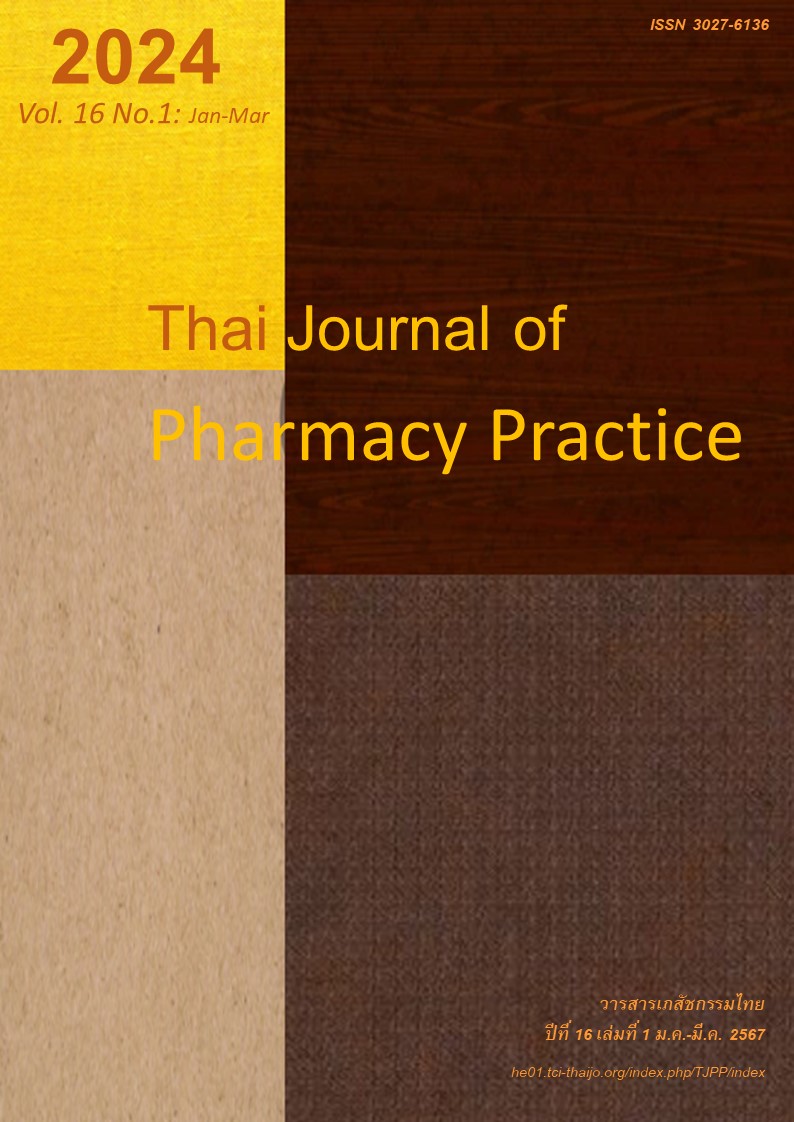ระดับภาวะหมดไฟและปัจจัยที่มีความสัมพันธ์กับภาวะหมดไฟในนิสิตเภสัชศาสตร์
Main Article Content
บทคัดย่อ
วัตถุประสงค์ : เพื่อประเมินระดับภาวะหมดไฟ และศึกษาความสัมพันธ์ระหว่างปัจจัยส่วนบุคคล ปัจจัยด้านการจัดการเรียนการสอน และระดับความไม่ลงตัวของบุคคลกับสถานการณ์ในการเรียน 6 ประเภทกับภาวะหมดไฟในนิสิตเภสัชศาสตร์ วิธีการ: การวิจัยเชิงสำรวจครั้งนี้ทำในนิสิตเภสัชศาสตร์ชั้นปีที่ 2-6 ของมหาวิทยาลัยแห่งหนึ่ง และมีอายุ 20 ปีขึ้นไป จำนวน 217 คน การสำรวจใช้แบบสอบถามออนไลน์ระหว่างวันที่ 20 มกราคม- 25 กุมภาพันธ์ พ.ศ. 2563 ผลการวิจัย: นิสิตตอบกลับจำนวน 189 คน คิดเป็นอัตราการตอบกลับร้อยละ 87.1 ผู้ตอบกลับส่วนใหญ่มีความอ่อนล้าทางอารมณ์อยู่ในระดับสูง และมีการลดค่าความสำเร็จส่วนบุคคลอยู่ในระดับต่ำ คิดเป็น ร้อยละ 69.3 และ 92.6 ตามลำดับ และมีการลดค่าความเป็นบุคคลอยู่ในระดับต่ำ ปานกลาง และสูงในจำนวนใกล้เคียงกัน คือ ร้อยละ 38.6, 30.2 และ 31.2 ตามลำดับ การศึกษาพบความสัมพันธ์อย่างมีนัยสำคัญทางสถิติ (P<0.05) ของภาวะหมดไฟและปัจจัยต่าง ๆ ดังนี้ ความอ่อนล้าทางอารมณ์มีความสัมพันธ์กับเหตุผลหลักในการเข้าศึกษา ระดับความเครียดจากการเรียนและการสอบ และความไม่ลงตัวของบุคคลในเรื่องของการไม่สามารถควบคุมการเรียนของตนเอง การขาดการยอมรับหรือชื่นชมถึงคุณค่าของตนเอง การขาดปฏิสัมพันธ์ที่ดีกับเพื่อน และความขัดแย้งระหว่างอุปนิสัยส่วนบุคคลกับการเรียน การลดค่าความเป็นบุคคลมีความสัมพันธ์กับเพศ ชั้นปี จำนวนชั่วโมงเรียนหรือชั่วโมงฝึกงาน และความไม่ลงตัวของบุคคลกับสถานการณ์ในการเรียนทั้งหกด้าน ส่วนการลดค่าความสำเร็จส่วนบุคคลไม่มีความสัมพันธ์กับทุกปัจจัย สรุป: นิสิตมีภาวะหมดไฟจากการเรียน ซึ่งส่งผลให้เกิดความเครียด ดังนั้น ควรจัดการเรียนและการสอบให้เหมาะสมกับผู้เรียน รวมทั้งมีการวางแผนจัดการเรียนทั้งในชั้นเรียนและการเสริมประสบการณ์นอกชั้นเรียน การให้รางวัล การจัดกิจกรรมกลุ่ม และการพักผ่อนอย่างเหมาะสม เพื่อยกระดับคุณภาพชีวิตและผลสัมฤทธิ์การเรียนอย่างยั่งยืน
Article Details

อนุญาตภายใต้เงื่อนไข Creative Commons Attribution-NonCommercial-NoDerivatives 4.0 International License.
ผลการวิจัยและความคิดเห็นที่ปรากฏในบทความถือเป็นความคิดเห็นและอยู่ในความรับผิดชอบของผู้นิพนธ์ มิใช่ความเห็นหรือความรับผิดชอบของกองบรรณาธิการ หรือคณะเภสัชศาสตร์ มหาวิทยาลัยสงขลานครินทร์ ทั้งนี้ไม่รวมความผิดพลาดอันเกิดจากการพิมพ์ บทความที่ได้รับการเผยแพร่โดยวารสารเภสัชกรรมไทยถือเป็นสิทธิ์ของวารสารฯ
เอกสารอ้างอิง
Maslach C, Jackson SE. Manual of the Maslach burnout inventory. 2nd ed. CA: Consulting Psycholo- gists Press; 1986.
Maslach C, Goldberg J. Prevention of burnout: New perspectives. Appl Prev Psychol 1998; 7: 63-74.
Frajerman A, Morvan Y, Krebs MO, Gorwood P, Chaumette. Burnout in medical students before residency: a systemic review and meta-analysis. Eur Psychiatry 2019; 55: 36-42.
Rosen IM, Gimotty PA, Shea JA, Bellini LM. Evolution of sleep quantity, sleep deprivation, mood distur- bances, empathy, and burnout among interns. Acad Med 2006; 81: 82-5.
Ried LD, Motycky C, Mobley C, Meldrum M. Comparing self-reported burnout of pharmacy students on the founding campus with those at distance campuses. Am J Pharm Educ 2006; 70: 114. doi: 10.5688/aj7005114.
Therdthoonphuphuch Sh. W, Lueboonthavatchai P. Work stress and burnout among licensed lawyers at Thai Lawyers Council under Royal Patronage. Chula longkorn Medical Journal 2017; 61: 663–76.
Vichanjalearnsuk V, Supapong S. Job burnout and related factors among pharmaceutical representa- tives of international pharmaceutical company. Tham masat Medical Journal 2015; 15: 225-31.
Singhnoy Ch. The causal relationship of factors affecting in athletic burnout [dissertation]. Chonburi: Burapha University; 2008.
Summawad S. Burnout among the staff nurses in Ramathibodi Hospital. [master thesis]. Nakhon Pathom: Mahidol University; 1989.
Siwakarn W. Job burnout in hospital pharmacists, Office of the Permanent Secretary of Ministry of Public Health [master thesis]. Nakorn Pathom: Silpakorn University; 2010.
Intakaew A, Akaraphattanawong A. A study of burnout in studying English of undergraduate students of Rajapark instiiute. Rajapark Journal 2017; 11: 135-49.
Taikerd K, Ruama K, Preecharlerdsin N, Nuallaong W, Rojpibulstit P. Prevalence and associated factors of burnout syndrome in preclinical medical students, Thammasat University. Thammasat Medical Journal 2019; 19 (supplement S127-38.
Phromsan T, Aroonthin T, Manyoo B. Burnout of the 4th year medical student, Naresuan University. CMU Journal of Education 2021; 5: 1-10.
Klebbua C, Sutiwan P. Development of the causal models of burnout at work. Journal of Research Methodolog 2009; 22: 411-26.
El-Ibiary YS, Yam L and Lee KC. Assessment of burnout and associated risk factors among pharmacy practice faculty in the United States. Am J Pharm Educ 2017; 81: 75. doi: 10.5688/ajpe81475.
Srikam S, Jiamjarasrangsi W, Lalitanantpong D. Job burnout and related factors among residents of King Chulalongkorn memorial hospital. Journal of the Psychiatric Association of Thailand 2014; 59: 139-50.
Pongpisanrat C. Learning burnout: An inevitable circumstance. Journal of Education, Mahasarakham University 2021; 15: 7-16.


